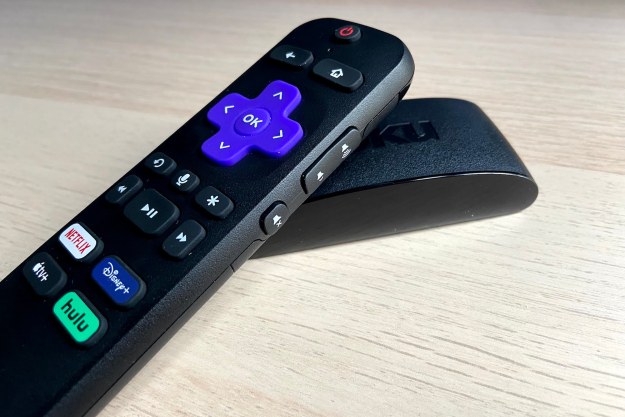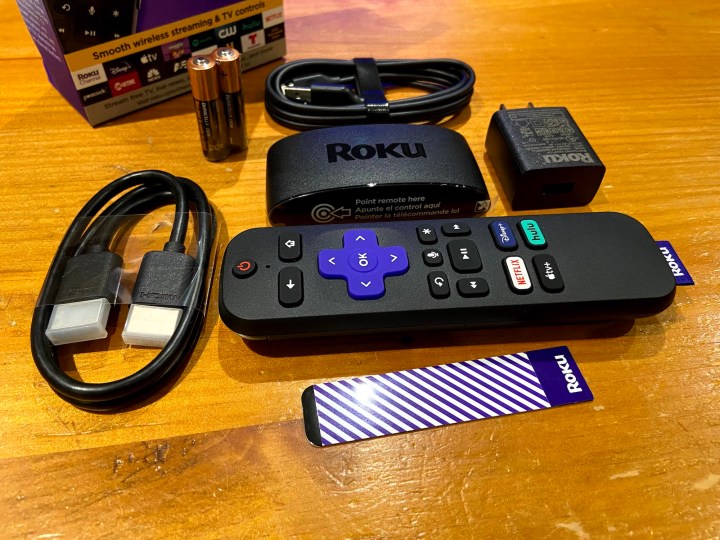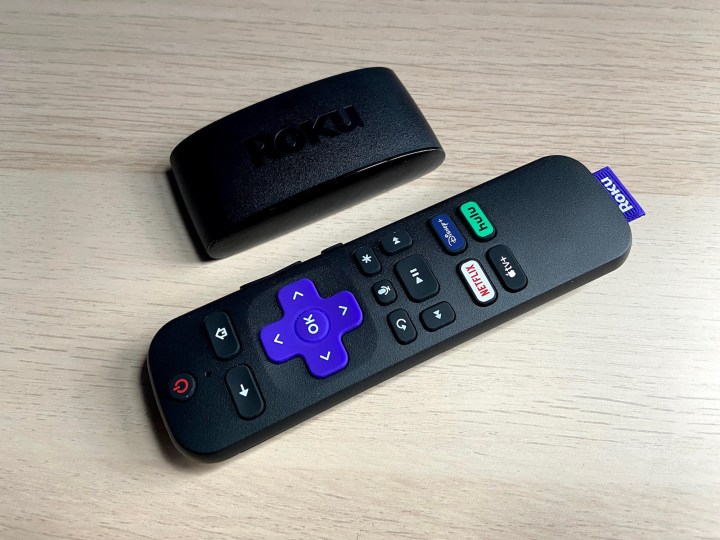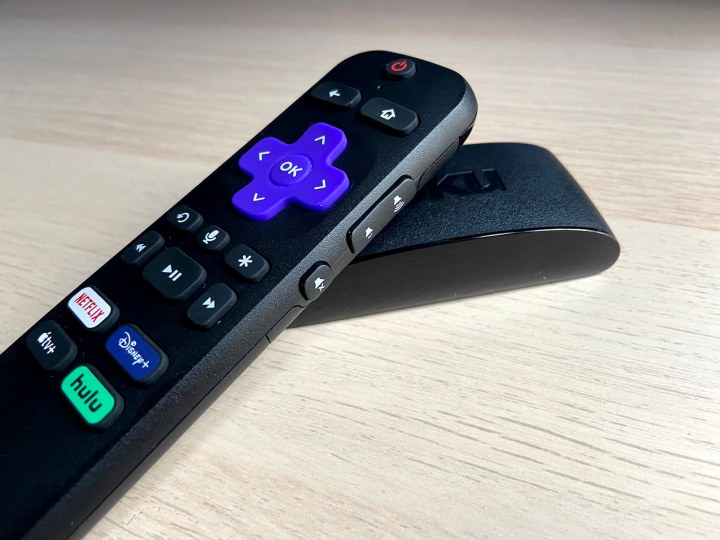
- Very affordable
- Simple, intuitive interface
- 4K, HDR, and Dolby Atmos passthrough
- Voice-capable, wireless remote
- Apple AirPlay
- Limited Dolby Atmos support
- No Dolby Vision
For Roku fans who are ready to take the plunge into 4K streaming, there’s a new kid in town: The $40 Roku Express 4K+, a device that looks like the $30 Roku Express, but actually has nearly the same features as the $50 Roku Streaming Stick+.
But does it make sense to save $10 to buy the Express 4K+ instead of buying the Streaming Stick+? And how does this new Roku device compare to Amazon’s family of Fire TV devices?
Check out our full review below for all of the answers.
What’s in the box?

Roku gives you everything you need to get set up. You get the Express 4K+, a high-speed certified HDMI cable, a Roku remote, a pair of AAA batteries, a Micro USB power cable with an AC adapter, a quick-start guide, and an adhesive strip that you can use to mount the Express 4K+ to a variety of surfaces, including the bottom edge or backside of your TV.
Design

It’s hard to find fault with the design of the Express 4K+. It’s a tried-and-true combination of the Roku Express’ tiny, curved black box, and the voice remote of the Streaming Stick+.
It’s so small and light that you’ll probably need the included adhesive strip just to keep the HDMI cable from pushing the Express 4K+ around.
On its back panel, you’ll find just two ports — a Micro USB jack for power and an HDMI port. Not that this is likely to be an issue in 2021, but it’s worth noting that if your TV doesn’t have an HDMI input, you won’t be able to use the Express 4K+. In fact, none of Roku’s current lineup of player devices supports non-HDMI TVs any longer.
Over the years, Roku has continued to refine its setup process for new devices, and it couldn’t be easier.
There’s no Ethernet port, but the Express 4K+ is compatible with a variety of third-party Micro USB Ethernet adapters should you need one.
When you unpack the box, you’ll see a sticker on the front of the device that indicates where you should point the remote. If you stick with the included Roku voice remote, you can safely ignore this — the remote can communicate with the Express 4K+ wirelessly and only uses infrared if it needs to send commands to your TV. This also means you can tuck the streamer out of your line of sight if you wish — something you can’t do with the regular Roku Express, or with the Express 4K, a $35 Walmart-only variant that doesn’t come with the wireless-capable Roku voice remote.
Speaking of the remote, it features a voice button, a built-in microphone, and dedicated buttons on the side for controlling a TV’s volume and mute functions.
Wondering what the difference is between the Express 4K+ and the Streaming Stick+? Two things: The Streaming Stick+ has faster, longer-range Wi-Fi, and it’s more portable because it doesn’t require an HDMI cable. Yup, that’s it.
Setup and configuration

Over the years, Roku has continued to refine its setup process for new devices, and it couldn’t be easier.
Once you plug the Express 4K+ into your TV via the included HDMI cable (or one of your own), plug it into power, and then slip the batteries into the remote. That’s it — you’re done with the hardware part.
From there, the Roku interface guides you smoothly through connecting to your home Wi-Fi and creating or connecting to an existing Roku account.
Pro tip: You’ll want your phone, tablet, or laptop standing by as part of the setup process involves sending you a confirmation email, which you’ll have to open and than click the included link to complete the setup.
I didn’t have to adjust any of the audio or video settings. To borrow one of Apple’s favorite phrases, it just worked.
I’ve set up a lot of streaming devices and the Roku procedure is second only to Apple in terms of simplicity.
You’ll be prompted to add some highlighted channels (the name that Roku continues to use for streaming apps), but don’t feel you need to do so now — channels can be easily added later through the Roku interface, the Roku app on your phone, or even on the web using the Roku website.
My review model immediately recognized that it was connected to a 4K HDR-capable TV and I didn’t have to adjust any of the audio or video settings manually. To borrow one of Apple’s favorite phrases, it just worked.
Right before you begin using the Express 4K+, Roku plays an introductory video that walks you through the device’s main features and how to use them. It’s the perfect way to get to know the Express 4K+, and I think every streaming device maker should follow Roku’s lead on this. It’s a device that plays video — why wouldn’t you show people a quick how-to video?
The interface is very fast, with no perceptible lag at all.
Another tip: The Express 4K+ ships with a power adapter, but you can plug the Micro USB cable into an available USB port on your TV and it should work just fine.
Even on my test LG TV, which tends to power down its USB ports when the TV isn’t in use, the Express 4K+ worked just fine and even responded to the remote’s power button when everything was shut down.
Ease of use and performance

Roku has given the Express 4K+ 1GB of RAM, an upgraded processor, and very fast MIMO Wi-Fi AC — and the results are impressive.
The interface is very fast, with no perceptible lag at all. For the most part, channels launch quickly (some a little quicker than others), and jumping from an open channel back to the home screen and then into a different channel is a snap.
Making content selections within channels was just as responsive, and movies and shows started to stream as fast as they do on an Apple TV 4K or Nvidia Shield — and significantly faster than the built-in apps on my LG C7 OLED 4K TV.
Roku’s interface has changed little over the years, and that’s mostly a good thing. The simple, straightforward menu options are a breeze to use, whether you’re looking for a favorite channel, tweaking device settings, or shopping for new channels in the Roku Channel Store.
Roku has resisted the trend of adding a content-curation layer to its main interface, relying instead on the free Roku Channel app (channel?) as its primary way of helping you find something to watch.
This may not feel as modern as say, Google TV, the recently revamped Fire TV interface, or the Apple TV home screen, but I confess I prefer being able to decide if I want to be shown a bunch of content, or whether I’d prefer to dive straight into a specific streaming service.
Recently, Roku added Apple AirPlay to select 4K-capable player devices, and the Express 4K+ gave me my first taste of this feature on a Roku.
I’m happy to report it works flawlessly. The Express 4K+ showed up in my list of available AirPlay devices, and I was able to quickly establish an AirPlay session. After that, it didn’t matter whether I was playing music from Apple Music or Tidal, or streaming from Netflix, Amazon Prime Video, or Disney+ — the content showed up on my TV without any buffering or other connection hiccups. I didn’t test the available integration with Apple HomeKit, but both Amazon Alexa and Google Assistant were able to control the Express 4K+ without problems.
Voice commands using the remote were equally slick and satisfying, and I was able to open channels and search for actors and movie titles.
Audio and video

There’s no question that if you own a Dolby Vision-capable TV, it makes sense to get a Dolby Vision-capable streaming device. However, if you’re determined to stick with Roku, you’ll have to spend $100 to buy the Roku Ultra, which is the only Roku player device that works with Dolby’s dynamic HDR format.
The Express 4K+ has excellent picture quality, with tack-sharp details.
As much of a fan of Dolby Vision as I am, it’s hard to argue that this one feature is worth spending an extra $60 (150% more) over the price of the Express 4K+ to get it — especially when 4K with regular HDR10 looks so damned good. It’s also worth noting that despite the absence of Dolby Vision, the Express 4K+ does support HDR10+. As a dynamic HDR format, it has the potential to look as good as Dolby Vision, but keep in mind that your TV needs to support it (not all HDR TVs do) and you’ll need to find HDR10+ content. So far, Amazon Prime Video is your best bet for HDR10+.
The Express 4K+ has excellent picture quality, with tack-sharp details. Even when streaming HD content from sources like Amazon Prime Video, I found I was perfectly satisfied with the results.
What may be more impressive is that the Express 4K+ can pass through Dolby Atmos content via Dolby Digital Plus over HDMI.
For me, that translated into superb Atmos audio both on my TV’s internal speakers, as well as my full home theater 5.1.2 system.
There is one caveat here: Dolby Atmos support when provided via passthrough (as opposed to native Atmos decoding) is done on an app-by-app (channel-by-channel?) basis. At the moment, Netflix is the only streaming app that delivers Dolby Atmos on the Express 4K+. Could this change in time? Absolutely, but for now, it’s best to think of the Express 4K+ as a Dolby 5.1 device.
If you’re curious about all the ins and outs of getting great Dolby Atmos sound, check out this handy explainer.
There’s an app for that

No review of a Roku product is complete without at least a passing mention of the company’s superb mobile app. Not only can you use it as a full-fledged alternative to the remote that shipped with your product, but it also enables private listening (watch on your TV while you listen via your phone’s headphones), and it gives you the ability to add and remove Roku channels even when your Roku device is turned off.
Better still, it acts as your mobile version of the Roku Channel, with access to all of the same content that you’d get on your TV.
The Roku app is an impressive extra that, so far, no other streaming device company can match.
Our take
Incredibly easy to set up and use, the Roku Express 4K+ exceeds our expectations for what a $40 streaming media device can do.
Is there a better alternative?
At this price, the Express 4K+ has two very good direct competitors: The recently refreshed Amazon Fire TV Stick and the TiVo Stream 4K.
The Fire TV Stick and Stream 4K both feature native Dolby Atmos decoding, which means that many more streaming apps should work with this feature. The Stream 4K also has Dolby Vision — a big plus for those who have compatible TVs.
But neither of these devices supports Apple AirPlay or HomeKit, and we’d argue that the Roku interface is still a more appealing way to navigate a streaming device than either Amazon’s Fire TV or Android TV (especially as the Stream 4K lacks Google TV).
And neither of these devices has an equivalent to the excellent Roku mobile app.
Unless you feel that the Fire TV Stick or Stream 4K has a feature you can’t live without, I think you’ll be very happy with the Roku Express 4K+.
How long will it last?
Roku player devices come with a one-year warranty. My experience with most streaming devices is that as long as you don’t inadvertently damage them, they’ll work for years. The Express 4K+ is just as well-built as Roku’s other players — which is to say, very well built — and the remote control is robust despite being lightweight.
Roku also has an excellent track record in keeping its older devices updated with new software over time.
Should you buy it?
Absolutely. If you want to enjoy 4K HDR streaming for the lowest possible price, the Roku Express+ gives you that and a whole lot more.
Editors' Recommendations
- Best Samsung TV deals: Save on 4K TVs, QLED TVs, OLED TVs, 8K TVs
- Sony debuts the Bravia 9, its brightest 4K TV ever, alongside new 2024 models
- Let’s discuss an Apple TV 4K with a camera
- Best 65-inch TV deals: Get a 65-inch 4K TV for under $400
- Vizio’s first 86-inch 4K TV is coming soon, for $999





